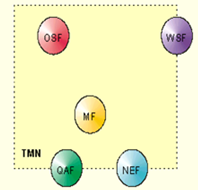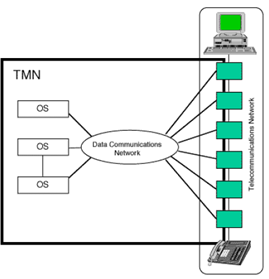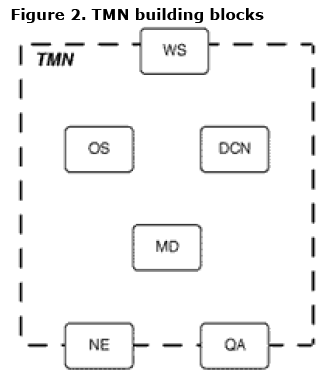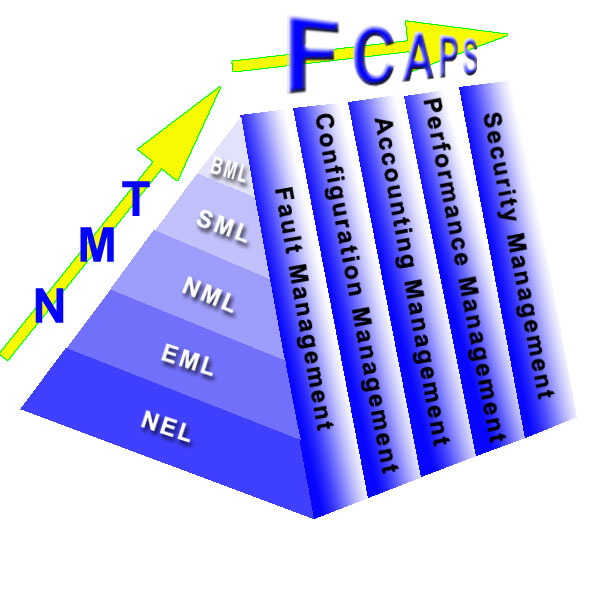Mia Savira Karthin
110400254
Telecommunication Management Network (TMN)
Telecomunication Management Network (TMN) adalah suatu standar arsitektur manajemen jaringan yang digunakan untuk mengumpulkan, mengirimkan dan mengolah informasi yang berkaitan dengan manajemen jaringan. Tujuan TMN sendiri adalah mendukung proses administrasi pada manajemen jaringan telekomunikasi. TMN dikembangkan olehInternational Telecomunication Union ( ITU) sebagai sebuah infrastruktur untuk mendukung pengaturan dan penyebaran layanan telekomunikasi yang dinamis.
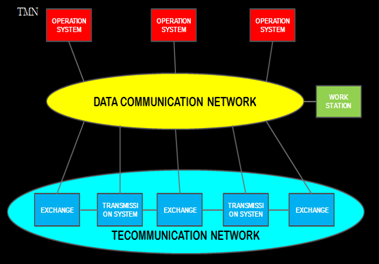
Telecomunication Management Network (TMN) mengembangkan sebuah framework untuk jaringan yang fleksibel, terukur, reliabel, murah untuk dijalankan dan mudah meningkatkan kualitas jaringan. Untuk mencapai hal ini, TMN mendefinisikan saru set poin untuk elemen interface yang melakukan proses komunikasi yang akan diakses oleh elemen seperti workstation manajemen, digunakan untuk memantau dan mengendalikan jaringan. Standar interface memungkinkan elemen-elemen dari berbagai produsen untuk dimasukkan ke dalam jaringan di bawah kontrol manajemen tunggal. Untuk komunikasi antara Operasi Sistem dan SPN (Jaringan Unsur) menggunakan protokol manajemen informasi umum (CMIP) atau perangkat Mediasi ketika menggunakan antarmuka Q3. TMN dapat digunakan dalam pengelolaan ISDN, B-ISDN, ATM, dan jaringan GSM. Hal ini tidak umum digunakan untuk murni packet switched jaringan data. Sebuah TMN menyediakan sarana untuk informasi transportasi dan proses yang terkait dengan pengelolaan jaringan telekomunikasi.
Pada umumnya konsep manajemen TMN memperkenalkan beberapa manajemen arsitektur pada tingkat abstraksi yang berbeda, yaitu:
- A functional architecture, yang menjelaskan jumlah dari manajemen fungsi.
- A physical architecture, yang mendefinisikan bagaimana fungsi-fungsi manajemen dapat diimplementasikan ke dalam peralatan fisik.
- An information architecture, yang menjelaskan konsep-konsep yang bersumber dari manajemen OSI.
- A logical layered architecture (LLA), yang termasuk salah satu gagasan terbaik dari TMN: sebuah model yang menunjukkan bagaimana manajemen dapat distrukturisasi menurut tanggung-jawab yang berbeda.
Arsitektur TMN fungsional didasarkan pada sejumlah blok fungsi TMN. Blok fungsi ini memberikan TMN dengan fungsi yang memungkinkan untuk melakukan fungsi manajemen TMN. Fungsi blok TMN tersebut dibagi atas 5 bagian yaitu Operations Systems Function (OSF), Netwrok Elements Function (NEF), Workstation Function (WSF), Mediation Function (MF), Q Adaptor Function (QAF).
TMN memiliki sejumlah komponen fungsional yang telah teridentifikasi yaitu Management Application Function (MAF), Mediation Function-Management Application Function (MF- MAF), Operation System Function – MAF, Network Element Function–MAF, Adaptor Function–MAF, Information Conversion Function (ICF), Workstation Support Function (WSSF), User Interface Support Function (UISF), Message Communication Function (MCF). Untuk menggambarkan blok fungsi manajemen, maka diperkenalkan konsep titik referensi. Titik acuan menentukan layanan batas antara dua blok fungsi manajemen. Untuk sepasang blok fungsi tertentu, informasi lewat antara mereka dapat dicirikan dengan daftar interaksi yang sesuai untuk pasangan blok fungsi.
Cakupan TMN dimulai dari hubungan sederhana antara sebuah OS dengan suatu perangkat telekomunikasi tertentu hingga hubungan yang sangat kompleks antara suatu OS dengan berbagai perangkat telekomunikasi. TMN menyediakan berbagai macam fungsi manajemen dan menawarkan komunikasi antar OS maupun antara OS dengan berbagai bagian jaringan telekomunikasi, yang dapat meliputi perangkat telekomunikasi yang disebut elemen jaringan dengan sistem digital maupun analog, sistem penyambungan (switching), berbagai multiplexer, terminal signaling dan seterusnya.
Telecommunication Management Network (TMN)
by International Engineering Consortium
1. Framework Telecommunication Management Network (TMN)
TMN menyediakan framework jaringan yang fleksibel, sesuai skala, handal, tidak mahal dan mudah dikembangkan agar dapat mengoptimumkan kinerja dan mencapai efisiensi komunikasi. Prinsip TMN adalah bekerjasama dalam jaringan telekomunikasi untuk mengirimkan dan menerima informasi dan mengelola sumber daya nya. TMN memungkinkan komunikasi antara operation support system (OSS) dan NE. Berikut gambar bagaimana TMN berkontribusi dalam jaringan telekomunikasi.
TMN menggunakan prinsip subject-oriented dan interface standar untuk mendefinisikan komunikasi antara entitas manajemen dalam jaringan. Interface standar ini dinamakan interface Q3. Arsitektur dan interface TMN dibangun dari standar open system interconnection (OSI). Standar ini mencakup : CMIP (common management information protocol), GDMO (guideline for definition of managed objects), ASN.1 (abstract syntax notation one) dan open system interconnect reference model.
2. Functional Telecommunication Management Network (TMN)
Sebuah TMN menyediakan sarana untuk informasi transportasi dan proses yang terkait dengan pengelolaan jaringan telekomunikasi. Arsitektur TMN fungsional didasarkan pada sejumlah blok fungsi TMN. Blok fungsi memberikan TMN dengan fungsi yang memungkinkan untuk melakukan fungsi manajemen TMN. Sebuah Data Communication Function (DCF) digunakan untuk mentransfer informasi antara blok fungsi TMN. Pasangan TMN blok fungsional yang pertukaran informasi manajemen yang dipisahkan oleh titik referensi antara mereka. Biasanya blok fungsional yang berbeda mungkin memiliki derajat yang berbeda dari pembatasan dalam lingkup pelaksanaan titik acuan yang sama. Fungsi yang disediakan oleh blok fungsi TMN akan diuraikan dalam bentuk komponen fungsional yang terdiri dari mereka. Berikut merupakan building blocks TMN :
Keterangan :
OS = Operations Systems
MD = Mediation
WS = Work Station
NE = Network Element
QA = Q Adaptor
…. = The TMN Function Boundary
Fungsi masing masing komponen adalah sebagai berikut :
OS : informasi yang berhubungan dengan manajemen telekomunikasi untuk maksud monitoring / koordinasi dan atau pengendalian fungsi telekomunikasi termasuk fungsi manajemen itu sendiri.
NE : Function block yang berkomunikasi dengan TMN dan berlaku sebagai pihak yang dikendalikan/dimonitor. NE menyediakan fungsi telekomunikasi dan pendukung yang diperlukan oleh jaringan telekomunikasi yang di-manage. NE menyediakan fungsi telekomunikasi yang menjadi subjek dari manajemen. Fungsi ini bukan bagian dari TMN tetapi dirpresentasikan ke TMN oleh NE. Bagian NE yang merepresentasikan fungsi tersebutlah yang menjadi bagian dari TMN.
WS : Menyediakan sarana untuk menginterpretasikan informasi TMN ke pengguna dan sebaliknya. Tanggung jawab WS adalah sebagai penterjemah atara titik referensi TMN dengan non-TMN.
MD : Blok MF berfungsi untuk memastikan bahwa informasi yang dipertukarkan antara OS dengan NE (atau QA) sesuai dengan keinginan dari function block yang terhubung dengan MF. MF blocks dapat menyimpan (store), menyesuaikan (adapt), menyaring (filter), threshold dan condense informasi.
QA : Digunakan untuk menghubungkan TMN dengan entitas non-TMN yang serupa dengan NEF atau OSF.
3. The Standard Interfaces
Dalam model, antarmuka spesifik antara dua komponen TMN saling berkomunikasi satu sama lain. Antarmuka TMN adalah :
Q à muncul antara dua fungsi TMN dalam domain yang sama.
F à MUNCUL antara WS dan OS dan antara WS dan MD
X à Muncul antara dua OS dalam dua domain terpisah, atau antara OS TMN dan OS non-TMN lain dalam jaringan.
Ada dua kelas interface Q, yaitu Q3 dan Qx. Gambar 4 mengilustrasikan fungsional blok bisa berkomunikasi melalui interface Q. interface Q3 meruoaja jalur menuju sistem operasi, merupakan satu satunya antarmuka yang bisa digunakan Qas, MDs atau Nes untuk berkomunikasi langsung dengan OS. Antarmuka Qx beroperasi dengan MD. MD dapat menginterpretasikan antara informasi manajemen lokal yang disediakan antarmyka Qx dan informasi OS yang disediakan antarmuka Q3.
4. The Telecommunication Management Network Logical Model
- BML (Business-management layer), berkonsentrasi pada perencanaan tingkat tinggi, budgeting, penetapan tujuan, keputusan eksekutif, business level agreement (BLAs) dan sebagainya.
- SML (service-management layer), berkonsentrasi pada informasi yang ditampilkan oleh NML untuk mengelola jasa kontrak untuk pelanggan potensial dan pelanggan yang telah ada. SML juga merupakan poin kunci untuk berinteraksi dengan penyedia jasa dan dengan domain administratif lain.
- NML (network management layer), bertugas mengelola NE secara individual maupun secara grup. NML mengkoordinasikan semua aktivitas jaringan dan mendukung permintaan dari SML, OS dalam antarmuka NML dengan OS dalam SML melalui antarmuka Q3.
- EML (element management layer), mengelola masing-masing elemen jaringan. EML memiliki manajer elemen atau OS, masing-masingnya bertanggung jawab untuk informasi TMN yang telah dikelola dalam NE.
- NEL (network element layer), menampilkan informasi TMN yang telah dikelola dalam NE individual.
5. Telecommunication Management Network Solutions
Tantangan utama untuk penyedia jasa, original equipment of manufactures (OEMs), vendor software dan integrator adalah untuk mengembangkan TMN-conformant, memperkuat aplikasi yang bisa menampilkan variasi network management. Service provider dan vendor software dapat mengimplementasikan solusi :
- Memperkecil waktu untuk pasar
- Memperkecil biaya
- Mendukung peningkatan permintaan untuk kualitas yang lebih tinggi
- Menciptakan sistem nyang bisa bekerja sama
- Menyesuaikan diri ke standar industri untuk TMN.




